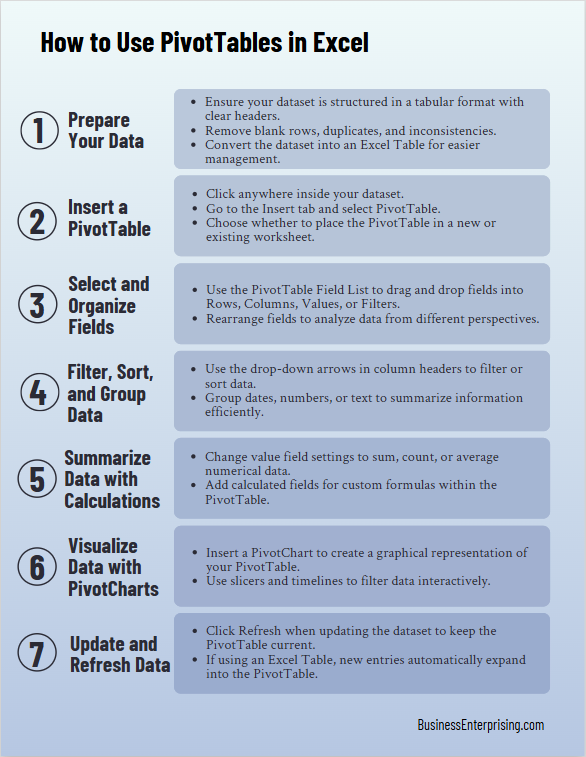 Navigating the vast amounts of data in today’s business environment can be challenging. Understanding how to use PivotTables can significantly enhance your data analysis capabilities. PivotTables are dynamic tools in Excel that allow you to summarize and analyze large datasets efficiently. They enable you to reorganize data, making it easier to identify patterns and trends. By transforming raw data into structured summaries, PivotTables help you make informed decisions. Whether you’re tracking sales performance or managing inventory, mastering PivotTables is essential.
Navigating the vast amounts of data in today’s business environment can be challenging. Understanding how to use PivotTables can significantly enhance your data analysis capabilities. PivotTables are dynamic tools in Excel that allow you to summarize and analyze large datasets efficiently. They enable you to reorganize data, making it easier to identify patterns and trends. By transforming raw data into structured summaries, PivotTables help you make informed decisions. Whether you’re tracking sales performance or managing inventory, mastering PivotTables is essential.
One of the primary benefits of PivotTables is their flexibility. You can quickly adjust the data view by dragging and dropping fields. This adaptability allows you to explore different perspectives without altering the original data. Additionally, PivotTables support various calculations, such as sums, averages, and counts. This functionality provides deeper insights into your data. Furthermore, you can apply filters to focus on specific subsets, enhancing your analytical precision.
Another advantage is the ability to create PivotCharts from PivotTables. These charts provide visual representations of your data, making complex information more accessible. They help you communicate findings effectively to stakeholders. Moreover, PivotTables can handle large datasets without compromising performance. This efficiency ensures that your analysis remains swift and responsive. By integrating PivotTables into your workflow, you can streamline data analysis processes.
Incorporating PivotTables into your skill set enhances your analytical capabilities. They empower you to transform extensive data into actionable insights. As a result, you can make data-driven decisions with confidence. Investing time in learning PivotTables yields significant returns in productivity and effectiveness. Embracing this tool is a step toward becoming proficient in data analysis.
Introduction to PivotTables and Their Importance
PivotTables are a powerful feature in Microsoft Excel that allow you to summarize and analyze large data sets efficiently. They enable you to reorganize and group data, making it easier to extract meaningful insights. By learning how to use PivotTables, you can transform complex data into understandable summaries, facilitating better decision-making.
One key benefit of PivotTables is their ability to handle large volumes of data without requiring complex formulas. This functionality allows you to quickly identify trends and patterns that might not be immediately apparent. Additionally, PivotTables offer flexibility; you can easily adjust the data fields to view information from different perspectives. This adaptability is particularly useful when exploring various scenarios or answering specific business questions.
Moreover, PivotTables enhance data accuracy by reducing manual calculations, thereby minimizing the risk of errors. They also facilitate efficient reporting, enabling you to create interactive and customizable reports that cater to diverse audiences. This capability ensures that stakeholders receive relevant information tailored to their needs, enhancing communication and understanding.
Incorporating PivotTables into your data analysis toolkit can significantly improve your efficiency and effectiveness. They empower you to transform raw data into actionable insights, supporting strategic planning and operational improvements. As a result, mastering PivotTables is a valuable skill for any business professional aiming to leverage data for success.
Preparing Your Data for PivotTable Analysis
Properly preparing your data is essential for effective PivotTable analysis in Excel. A well-structured dataset not only ensures accuracy but also leads to more insightful results. Before learning how to use PivotTables, it is important to focus on meticulously organizing your raw data. This foundational step enhances efficiency and prevents errors later in the process.
To begin, structure your data in a tabular format. Each column should have a unique header that clearly defines the type of data it contains. For example, headers like “Date,” “Product,” “Sales,” and “Region” create clarity and consistency. Additionally, avoid merging cells, as this disrupts PivotTable functionality. Furthermore, ensure your data range remains continuous, without blank rows or columns. By maintaining a structured format, Excel can recognize and process the dataset more efficiently.
Next, clean and format your data to improve accuracy. Removing duplicate entries helps maintain data integrity. Additionally, make sure numerical data is free from text characters or symbols, as these can cause calculation errors. Converting text-based numbers into numerical format ensures proper analysis. Furthermore, checking for and correcting inconsistencies—such as varying date formats or misspelled categories—improves data reliability. A consistent dataset leads to more accurate and meaningful PivotTable results.
Moreover, converting your dataset into an Excel Table before creating a PivotTable offers several advantages. This step enables automatic data range expansion when adding new entries. Additionally, Excel Tables provide built-in filtering and styling options, improving data management. To convert your dataset, select the data range and press Ctrl + T, or go to the “Insert” tab and click “Table.” By doing so, you streamline the process of creating and updating PivotTables.
Creating a PivotTable Step-by-Step
Creating a PivotTable in Excel is a straightforward process that enhances your data analysis capabilities. First, select any cell within your dataset. Then, navigate to the ‘Insert’ tab and choose ‘PivotTable’. Excel will prompt you to confirm the data range and select a location for the PivotTable, either in a new worksheet or the existing one. After confirming, Excel generates a blank PivotTable framework.
Next, you’ll see the PivotTable Field List on the right side of the screen. This pane displays all column headers from your dataset as fields. To organize your data, drag desired fields into one of four areas: Filters, Columns, Rows, or Values. For example, placing ‘Product’ in Rows and ‘Sales’ in Values will display total sales per product. Adjusting these fields allows you to explore different data perspectives efficiently.
Understanding how to use PivotTables empowers you to summarize and analyze large datasets effectively. By customizing the arrangement of fields, you can uncover trends and insights that inform better business decisions. This flexibility makes PivotTables an invaluable tool for professionals seeking to interpret complex data with ease.
Customizing PivotTables for Better Insights
Customizing PivotTables enhances your data analysis by allowing tailored insights. Sorting, filtering, and grouping data are essential techniques. Sorting arranges your data in ascending or descending order, making patterns more visible. To sort, click the drop-down arrow next to a field label and choose your preferred order. Filtering refines your data by displaying only the information that meets specific criteria. For example, to view sales from a particular region, use the filter option on the region field. Grouping consolidates data into categories, simplifying analysis. You can group dates by months or numerical data into ranges. Right-click the desired items and select ‘Group’ to do this.
Calculated fields and value summaries further enhance PivotTable functionality. Calculated fields allow you to create new data points using existing ones. For instance, you can calculate profit by subtracting costs from revenue directly within the PivotTable. To add a calculated field, go to the ‘PivotTable Analyze’ tab, click ‘Fields, Items, & Sets,’ and choose ‘Calculated Field.’ Value summaries determine how data is aggregated. By default, PivotTables sum numerical data, but you can change this to average, count, or other functions. Click on the value field, select ‘Value Field Settings,’ and choose your desired summary function.
Understanding how to use PivotTables effectively involves mastering these customization techniques. They enable you to tailor your data analysis to specific needs, uncovering deeper insights and supporting informed decision-making. By sorting, filtering, grouping, and utilizing calculated fields, you transform raw data into meaningful information. This customization not only streamlines your workflow but also enhances the clarity and impact of your reports.
Visualizing Data with PivotCharts and Conditional Formatting
Visualizing data effectively is essential for deriving meaningful insights. PivotCharts and conditional formatting are two powerful tools in Excel that enhance data interpretation. Understanding how to use PivotTables lays the foundation for creating PivotCharts. To create a PivotChart, first, select any cell within your PivotTable. Navigate to the ‘Insert’ tab and click on ‘PivotChart’ in the ‘Charts’ group. Choose your desired chart type, such as a bar or line chart, and click ‘OK’. The PivotChart will appear alongside your PivotTable, providing a visual representation of your data. This dynamic chart updates automatically when you modify the PivotTable, ensuring consistency between your data and its visualization.
Conditional formatting further enhances data clarity by applying visual cues directly within your PivotTable. To apply conditional formatting, select the range of cells you wish to format. Then, go to the ‘Home’ tab, click on ‘Conditional Formatting’ in the ‘Styles’ group, and choose a formatting rule, such as ‘Highlight Cells Rules’ or ‘Data Bars’. For example, you can highlight cells greater than a specific value by selecting ‘Highlight Cells Rules’ > ‘Greater Than’ and entering your threshold. This technique draws attention to key data points, making patterns and outliers more noticeable.
Combining PivotCharts with conditional formatting transforms raw data into intuitive visuals, facilitating better decision-making. By leveraging these tools, you can present complex data in a more accessible and insightful manner, ultimately enhancing your analytical capabilities.
Advanced PivotTable Features for Deeper Analysis
Enhancing your data analysis with advanced PivotTable features can lead to deeper insights. Slicers and timelines offer intuitive filtering options. Slicers provide visual buttons for filtering data. To add a slicer, click anywhere in your PivotTable, go to the ‘Insert’ tab, and select ‘Slicer’. Choose the field you want to filter, and Excel will display a slicer box with buttons representing unique values from that field. Clicking these buttons filters your data instantly. Timelines, on the other hand, are specialized slicers for date fields. They allow you to filter data across periods like years, quarters, months, or days. To insert a timeline, select your PivotTable, navigate to the ‘Insert’ tab, and click ‘Timeline’. Choose your date field, and a timeline control will appear, enabling you to adjust the time span interactively.
Connecting multiple tables with Power Pivot further enhances your analytical capabilities. Power Pivot allows you to create data models by linking different tables through relationships. This means you can analyze data from multiple sources within a single PivotTable without consolidating them into one table. To utilize Power Pivot, ensure it’s enabled in Excel. Load your tables into the data model and establish relationships by matching fields, such as IDs or names. Once connected, you can build PivotTables that draw from these related tables, providing a comprehensive view of your data.
Understanding how to use PivotTables effectively involves leveraging these advanced features. Slicers and timelines offer dynamic filtering, making it easier to focus on specific data subsets. Power Pivot’s ability to connect multiple tables enables complex analyses without redundant data. By incorporating these tools, you can transform your data analysis approach, leading to more informed decisions and strategic insights.
Conclusion
Mastering how to use PivotTables can significantly enhance your data analysis capabilities. By organizing and summarizing complex datasets, PivotTables allow you to extract meaningful insights efficiently. Implementing best practices, such as ensuring your source data is clean and well-structured, further optimizes their effectiveness. Additionally, leveraging advanced features like slicers, timelines, and Power Pivot connections can provide deeper analytical perspectives. By integrating these techniques, you can transform raw data into valuable information, supporting informed decision-making and strategic planning.
For more information about PivotTables and other Excel functions, take the Microsoft Excel Online Course.



